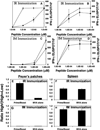Generation of functionally active HIV-1 specific CD8+ CTL in intestinal mucosa following mucosal, systemic or mixed prime-boost immunization
- PMID: 18793787
- PMCID: PMC4782776
- DOI: 10.1016/j.virol.2008.08.019
Generation of functionally active HIV-1 specific CD8+ CTL in intestinal mucosa following mucosal, systemic or mixed prime-boost immunization
Abstract
Gastrointestinal and vaginal mucosa are major sites of entry in natural HIV infection and therefore the preferred sites to elicit high-avidity CD8+ CTL by vaccination. We directly compare systemic and mucosal immunization in mice after DNA priming and boosting with rgp160 env expressed either in MVA or Ad for their ability to induce mucosal as well as systemic HIV-specific CTL. The optimal CTL response in the gut mucosa was observed after priming with the HIV-1 gp160 env DNA vaccine and boosting with rMVA or rAd encoding the same envelope gene all administered intrarectally (IR). Maximum levels of high-avidity CD8+ T cells were seen in intestinal lamina propria following this regimen. When the prime and boost routes were distinct, the delivery site of the boost had a greater impact than the DNA priming. IM DNA prime and IR rMVA boost were more effective than IR DNA prime and IM rMVA boost for eliciting mucosal CD8+ T-cell avidity. A systemic DNA-prime-followed by systemic rMVA boost induced high levels of high-avidity CD8+ T cells systemically, but responses were undetectable in mucosal sites. A single systemic immunization with rMVA was sufficient to induce high-avidity IFN-gamma secreting CD8+ T cells in systemic organs, whereas a single mucosal immunization with rMVA was not sufficient to elicit high-avidity CD8+ T cells in mucosa. Thus, a heterologous mucosal DNA prime-viral vectored boost strategy was needed. The requirement for a heterologous DNA prime-recombinant viral boost strategy for generation of high-avidity CD8+ T cells in mucosal sites in mice may be more stringent than for the induction of high-avidity CD8+ T cells in systemic compartments.
Figures




Similar articles
-
Gender differences in human immunodeficiency virus type 1-specific CD8 responses in the reproductive tract and colon following nasal peptide priming and modified vaccinia virus Ankara boosting.J Virol. 2004 Dec;78(23):13163-72. doi: 10.1128/JVI.78.23.13163-13172.2004. J Virol. 2004. PMID: 15542668 Free PMC article.
-
A novel functional CTL avidity/activity compartmentalization to the site of mucosal immunization contributes to protection of macaques against simian/human immunodeficiency viral depletion of mucosal CD4+ T cells.J Immunol. 2007 Jun 1;178(11):7211-21. doi: 10.4049/jimmunol.178.11.7211. J Immunol. 2007. PMID: 17513770
-
Simultaneous approach using systemic, mucosal and transcutaneous routes of immunization for development of protective HIV-1 vaccines.Curr Med Chem. 2011;18(26):3953-62. doi: 10.2174/092986711796957293. Curr Med Chem. 2011. PMID: 21824096
-
Control of a mucosal challenge and prevention of AIDS by a multiprotein DNA/MVA vaccine.Vaccine. 2002 May 6;20(15):1949-55. doi: 10.1016/s0264-410x(02)00076-2. Vaccine. 2002. PMID: 11983252 Review.
-
Clarification of how HIV-1 DNA and protein immunizations may be better used to obtain HIV-1-specific mucosal and systemic immunity.Expert Rev Vaccines. 2007 Apr;6(2):203-12. doi: 10.1586/14760584.6.2.203. Expert Rev Vaccines. 2007. PMID: 17408370 Review.
Cited by
-
Low Antigen Dose in Adjuvant-Based Vaccination Selectively Induces CD4 T Cells with Enhanced Functional Avidity and Protective Efficacy.J Immunol. 2017 May 1;198(9):3494-3506. doi: 10.4049/jimmunol.1600965. Epub 2017 Mar 27. J Immunol. 2017. PMID: 28348274 Free PMC article.
-
Mucosal immunology of HIV infection.Immunol Rev. 2013 Jul;254(1):10-33. doi: 10.1111/imr.12072. Immunol Rev. 2013. PMID: 23772612 Free PMC article. Review.
-
Safety and reactogenicity of canarypox ALVAC-HIV (vCP1521) and HIV-1 gp120 AIDSVAX B/E vaccination in an efficacy trial in Thailand.PLoS One. 2011;6(12):e27837. doi: 10.1371/journal.pone.0027837. Epub 2011 Dec 21. PLoS One. 2011. PMID: 22205930 Free PMC article. Clinical Trial.
-
Use of an in vivo FTA assay to assess the magnitude, functional avidity and epitope variant cross-reactivity of T cell responses following HIV-1 recombinant poxvirus vaccination.PLoS One. 2014 Aug 29;9(8):e105366. doi: 10.1371/journal.pone.0105366. eCollection 2014. PLoS One. 2014. PMID: 25170620 Free PMC article.
-
Route of adenovirus-based HIV-1 vaccine delivery impacts the phenotype and trafficking of vaccine-elicited CD8+ T lymphocytes.J Virol. 2010 Jun;84(12):5986-96. doi: 10.1128/JVI.02563-09. Epub 2010 Mar 31. J Virol. 2010. PMID: 20357087 Free PMC article.
References
-
- Acierno PM, Schmitz JE, Gorgone DA, Sun Y, Santra S, Seaman MS, Newberg MH, Mascola JR, Nabel GJ, Panicali D, Letvin NL. Preservation of functional virus-specific memory CD8+ T lymphocytes in vaccinated, simian human immunodeficiency virus-infected rhesus monkeys. J. Immunol. 2006;176(9):5338–5345. - PubMed
-
- Ahlers JD, Belyakov IM, Berzofsky JA. Cytokine, chemokine and costimulatory molecule modulation to enhance efficacy of HIV vaccines. Current Molecular Medicine. 2003;3:285–301. - PubMed
-
- Allen TM, Vogel TU, Fuller DH, Mothe BR, Steffen S, Boyson JE, Shipley T, Fuller J, Hanke T, Sette A, Altman JD, Moss B, McMichael AJ, Watkins DI. Induction of AIDS virus-specific CTL activity in fresh, unstimulated peripheral blood lymphocytes from rhesus macaques vaccinated with a DNA prime/modified vaccinia virus Ankara boost regimen. J. Immunol. 2000;164(9):4968–4978. - PubMed
Publication types
MeSH terms
Substances
Grants and funding
LinkOut - more resources
Full Text Sources
Other Literature Sources
Research Materials

